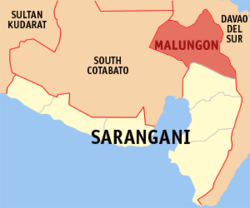Malungon, Sarangani
| Malungon | |
|---|---|
| Municipality | |
 Map of Sarangani with Malungon highlighted | |
.svg.png) Malungon Location within the Philippines | |
| Coordinates: 06°16′N 125°17′E / 6.267°N 125.283°ECoordinates: 06°16′N 125°17′E / 6.267°N 125.283°E | |
| Country | Philippines |
| Region | SOCCSKSARGEN (Region XII) |
| Province | Sarangani |
| District | Lone district |
| Barangays | 31 |
| Government[1] | |
| • Mayor | Reynaldo F. Constantino |
| Area[2] | |
| • Total | 750.92 km2 (289.93 sq mi) |
| Population (2010)[3] | |
| • Total | 95,044 |
| • Density | 130/km2 (330/sq mi) |
| Time zone | PST (UTC+8) |
| ZIP code | 9503 |
| Dialing code | 83 |
| Income class | 1st class |
Malungon is a 1st class municipality in the province of Sarangani, Philippines. According to the 2010 census, it had a population of 95,044 people.[3] As of 2010, it has a total voting population of 49,270 voters.[2]
Malungon is a landlocked town at the north-eastern part of Sarangani. It is bounded on the west by Tupi, South Cotabato, on the north by the province of Davao del Sur, east by the newly created province of Davao Occidental, on the south by Alabel, Sarangani and General Santos City, and on the south-west by Polomolok, South Cotabato.
Barangays
Malungon is politically subdivided into 31 barangays.[2]
- Alkikan
- Ampon
- Atlae
- Banahaw
- Banate
- B'Laan
- Datal Batong
- Datal Bila
- Datal Tampal
- J.P. Laurel
- Kawayan
- Kibala
- Kiblat
- Kinabalan1
- Lower Mainit
- Lutay
- Malabod
- Malalag Cogon
- Malandag
- Malungon Gamay
- Nagpan
- Panamin
- Poblacion
- San Juan
- San Miguel
- San Roque
- Talus
- Tamban
- Upper Biangan
- Upper Lumabat
- Upper Mainit
Roadtrips
The municipality is served as the main roadtrip to the province of Davao del sur and South Cotabato. It knowns as the longest roadtrip to Davao city.
Demographics
| Population census of Malungon | ||
|---|---|---|
| Year | Pop. | ±% p.a. |
| 1990 | 57,641 | — |
| 1995 | 92,433 | +9.25% |
| 2000 | 93,232 | +0.18% |
| 2007 | 95,993 | +0.40% |
| 2010 | 95,044 | −0.36% |
| Source: National Statistics Office[3] | ||
Economy
Malungon's economy is largely based on agriculture with a high level production of dried coconut meat. Animal husbandry is the second biggest income earner, notably cattle farming. Other agricultural products are coconuts, maize, sugarcane, bananas, pineapples, mangoes, pork, eggs, beef, marijuana Plantation and fish.
The economy has accelerated in the past decade driven by advances in global communication technology and the finishing of a modern highway that tremendously improved trade and transport.
References
- ↑ "Official City/Municipal 2013 Election Results". Intramuros, Manila, Philippines: Commission on Elections (COMELEC). 11 September 2013. Retrieved 14 May 2014.
- 1 2 3 "Province: SARANGANI". PSGC Interactive. Makati City, Philippines: National Statistical Coordination Board. Retrieved 14 May 2014.
- 1 2 3 "Total Population by Province, City, Municipality and Barangay: as of May 1, 2010" (PDF). 2010 Census of Population and Housing. National Statistics Office. Retrieved 14 May 2014.
External links
- Malungon Municipal Profile at the Province of Sarangani Official Website
- Philippine Standard Geographic Code
- Philippine Census Information
- Local Governance Performance Management System
 |
Malalag, Davao del Sur | Santa Maria, Davao Occidental |  | |
| Tampakan, South Cotabato Tupi, South Cotabato |
|
Malita, Davao Occidental | ||
| ||||
| | ||||
| Polomolok, South Cotabato | General Santos / Alabel |
| ||||||||||